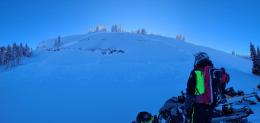Good morning. This is Dave Zinn with the Gallatin National Forest Avalanche Forecast on Tuesday, January 3rd at 7:00 a.m. This information is sponsored by Werner Wealth Management (Advisors with DA Davidson), the Community Food Co-op and Beartooth Powder Guides. This forecast does not apply to operating ski areas.
AVALANCHE FATALITY
On December 31, 2022, a very large avalanche killed a snowmobiler north of Cooke City. One rider in a group of two triggered the avalanche. The slide carried him 600 vertical feet and buried him 5 feet deep. Searchers located him with a probe line an hour after the avalanche occurred. Resuscitation efforts were unsuccessful. Our deepest condolences go out to the family, friends, and those involved with the rescue and recovery (Full details and photos here).
This morning, mountain temperatures are in the single digits to low teens F with 5-15 mph winds from the southwest. There is no new snow. Today, temperatures will reach the upper teens to mid-20s F with 5-15 mph wind from the southwest. The southern portions of the advisory area will get a trace to 1” of new snow by tomorrow morning.
With each day that passes without new snow, triggering an avalanche becomes slightly less likely. However, recent events make it clear that large, human-triggered avalanches are possible. While the likelihood decreases, the consequences of triggering an avalanche deep in the snowpack do not.
Yesterday, a group of riders in the Taylor Fork triggered a slide on a small, steep slope that broke 3-5 feet deep on weak snow near the ground (details and photos). Tragically, on the final day of 2022, a rider triggered a fatal avalanche on Crown Butte near Cooke City (video). A second, human-triggered avalanche in Cooke City broke under the weight of a rider in Sheep Creek (video, details). And yesterday, I rode into Lionhead to look at an avalanche that a group of riders triggered, also on December 31 (video and details). While snowmobilers triggered these recent avalanches, it could easily have been a skier, boarder or climber.
Persistent weak layers of sugary facets existing 1-2 feet below the surface and near the bottom of the snowpack on many slopes of the advisory area create this problem. Recent avalanche activity serves as the most reliable predictor of similar events today.
While we focus on large avalanches breaking deep in the snowpack, remember that smaller slides failing within recent and wind-drifted snow similar to the one on Saddle Peak two days ago are dangerous in steep or technical terrain (details and photo).
Give yourself a wide margin for error by treating all slopes over 30 degrees with suspicion, even when there are already tracks on the slope. Before considering travel in steep terrain, carefully assess the snowpack structure by looking for instability related to layers of sugary facets. And always, regardless of the danger, follow safe travel protocols by exposing only one person at a time to steep terrain, watching your partner from a safe location, and carrying avalanche rescue gear.
The danger is rated MODERATE.
Please share avalanche, snowpack or weather observations via our website, email (mtavalanche@gmail.com), phone (406-587-6984), or Instagram (#gnfacobs).
Triggering avalanches is slightly less likely with each day that passes without new snow. However, large, human-triggered avalanches breaking on persistent weak layers remain possible. Treat slopes over 30 degrees with suspicion, even when there are already tracks. Regardless of the danger, follow safe travel protocols by exposing only one person at a time to steep terrain, watching your partner from a safe location, and carrying avalanche rescue gear.
On New Year’s Day, I rode in Island Park and found persistent weak layers of sugary facets buried in a layer 1.5-2 feet deep and near the bottom of the snowpack (video). Before considering travel in steep terrain, assess the snowpack structure by looking for layers of sugary facets. If you find instability, avoid avalanche terrain.
Upcoming Avalanche Education and Events
Our education calendar is full of awareness lectures and field courses. Check it out: Events and Education Calendar.
January 4 + field day on January 7 or 8, Avalanche Fundamentals for Snowmobilers, Information and pre-registration HERE.
January 4 + field day, Avalanche Fundamentals for Skiers and Snowboarders, Information and pre-registration HERE.
Every Saturday, 10 a.m. - 2:00 p.m. Avalanche Rescue Training, drop in for any amount of time. Round Lake Warming Hut, Cooke City. Free.
Loss in the Outdoors, is a support group for those who have been affected by grief and loss related to outdoor pursuits. Check out the link for more information.
Please consider donating to the Friends of GNFAC Annual Fundraiser.
There was also an avalanche fatality on Saturday in Colorado. Two skiers were caught in an avalanche near Breckenridge after exiting the ski area. One skier was partially buried. After he extricated himself, he was unable to locate the other skier. An avalanche rescue dog team found the fully buried (deceased) skier two hours later (preliminary report).



